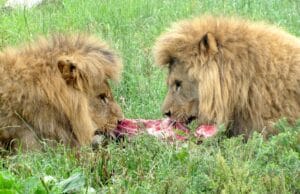Guest Blogger, Author James Welch has worked in zoos as a keeper for over 12 years focussing on carnivores and specialising in lions. He founded the Safina Lion Conservation Fund and has been its chairman since 2017. James has had the privilege of visiting East Africa four times, meeting several of the conservation partners that he’s been able to support. This blog takes a look at debunking a common misconception about lions.
We all know how lion society works don’t we? A big group of lions all live together guarded by an alpha male who leads the pride?
Now first things first, I love Disney’s ‘The Lion King’ I probably wouldn’t be where I am today without it. I haven’t looked back since I first watched it at the age of 3, but it could be responsible for some of the misinformation that is still out there about lion society today. This is particularly surprising given the fact that they are one of the most intensely studied large carnivores out there, with some really wonderful and in-depth studies being published since the 1960’s including classics by Guggisberg, Schaller, Bertram and Packer.

Male Zoo Lions at Knowsley Safari Park, UK ©James Welch
In truth, studies showed from the very beginning that male lions do not lead the pride, prides are very capably led by the lionesses! In fact, more than one male lion is normally associated with the pride. Male lions can live nomadically but those that go on to breed with the most success, live in groups called coalitions. Such alliances are often established along with other males they are related to and have grown up with once they reach dispersal age and leave their birth pride. However, what I find most interesting is that it is uncommon for coalitions to be formed from completely unrelated males. Males at a mature age have even been known to join former adversaries, if they both end up in similar positions. These alliances are formed out of a need to gain power. Power comes from a presence and large coalitions numbering four to six are not uncommon, numbers like this can allow the coalition to conquer larger territories and secure breeding rights over multiple prides.
Lions live in a fission-fusion society, meaning individuals may not spend all of their time together. Time together is dictated by available resources, which could differ massively throughout the year. On an individual basis bonds within these social groups tend to be closest between same-sex conspecifics, which means prides and coalitions remain very separate entities. The term ‘Pride Leader’ could not be further from the truth. The role of these males is to patrol the territory to defend the pride from male intruders who, if they enter, will kill any cubs that would inhibit the lionesses from being able to breed. Their time with the pride is limited. Coalitions compete against others for ownership rights to the pride territory and breeding privileges. They are not part of the pride in a traditional sense; they own the pride and the territory in which they live. Once they have been expelled, their circumstances will dictate their future. Nomadic life can be incredibly hard, and if injured, starvation is a very common cause of fatality, a fall from grace that happens to many of these wild kings. Although they are unable to stalk and ambush prey like the lionesses, male lions can hunt very well by using their brute strength on prey that does not require the element of surprise, with some coalitions becoming proficient hunters of buffalo and hippo, for example.
Applying This Knowledge to Zoos
Lions have long been kept in zoological collections across the world, and they were one of the first cats to breed well in captivity. They were also at the forefront of the safari revolution in the 1960’s/70’s and remain a very important part of what visitors still expect to see at most zoos.

©James Welch – Safina Lion Conservation Fund
How can we promote the welfare of such complex group living carnivores in captivity? It’s all about choices, the provision of multiple spaces, both indoor and outdoor, and varied spaces at that, enriching environments not only offer more exciting areas full of vegetation and natural furniture for the lions to explore and interact with but they can also provide visual barriers and changing topography to break up the environment that can help act as buffer zones during aggressive altercations. This can be achieved by thoughtful landscaping, providing multiple mounds (cats love a vantage point!) fallen trees and areas of dense foliage for example. The provision of larger communal spaces in indoor housing areas is also very important. This is a species that in the winter if warm and sheltered spaces are provided, they will use it. Larger houses with big communal spaces, soft substrates to provide multiple resting options throughout as well as access to separate areas all of the time can help give lions the space and opportunities to mitigate any group dynamic issues on their own terms, particularly when outside areas may not be preferable.
An in depth knowledge of species behaviour is critical when building environments and managing larger groups over time and this can be learnt from the wild. The power of giving individuals the space and freedom to choose who they want to be with and when is crucial, just because a group of lions have been together their whole life does not mean that they will get on well all of the time. Violence is an important part of lion society and displays of dominance will be witnessed and reaffirmed regularly as they are in the wild, lions have been built for this and are incredibly tough and robust but obviously this still requires careful monitoring and recording.
The Bigger Picture
Life on the African plains is timeless, and kings have battled kings to rule the savannahs for millennia but now due to human influence the clock has started ticking and it is getting louder and faster every day. We must not forget that mankind has lived rather peacefully with lions in these areas for an incredibly long time, but the wild is different now. The pressure of a burgeoning human population, growing agriculture and land use leading to the fragmentation of lion habitat and lion populations have increased the pressure between lions and people more than ever before. Today has never been so important, and zoos can and should play a huge role in educating their guests on the reality of life in the wild. Supporting conservation projects that help to protect lions and the communities that have to live alongside them in the wild where it matters should go hand in hand with keeping the species in our zoos. There was one aspect of lion life however that Disney got absolutely correct, every lion is a king in his own right. We need to respect their right to rule, as they will continue to demand it.
C.A.W Guggisberg (Simba, 1963) George Schaller (The Serengeti Lion, 1972) and Brian Bertram (Pride of Lions, 1978) Craig Packer (The Lion, 2023) (Lions In The Balance, 2015)
A guest blog in collaboration with Wild Welfare
The views, opinions and positions expressed by guest bloggers are theirs alone, and do not necessarily reflect the opinions of Wild Welfare or any employee thereof. Wild Welfare is not responsible for the accuracy of any of the information supplied by the guest bloggers. We accept no liability for any errors, omissions or representations. The copyright of this content (including images) belongs to the author and any liability with regard to infringement of intellectual property rights remains with them.









Discussion about this post